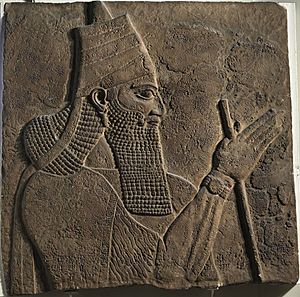Samsi facts for kids
Samsi (also called Shamsi) was a powerful Arab queen who lived a long time ago, in the 700s BCE. Her name means "my sun" in Arabic. She ruled in a region called the Ancient Near East, which included parts of today's Middle East.
Samsi became queen after Queen Zabibe. She ruled for about 20 years. During her time, the mighty Assyrian Empire, led by King Tiglath-Pileser III, started to control the Arab lands. Samsi first agreed to be loyal to Assyria. But later, she joined other rulers to fight against King Tiglath-Pileser III. Even though she was defeated, she was allowed to keep her throne after agreeing to pay a special tax called a tribute. Queen Iatie became queen after Samsi around 700 BCE.
Contents
Queen Samsi's Reign
The Assyrian records tell us that Queen Samsi was a strong leader. She was brave enough to challenge the Assyrian kings in the 730s and 720s BCE. Samsi and other rulers from lands far west of Assyria knew about the Assyrian kings. They often traded valuable spices with them.
Queens like Samsi, her predecessor (the queen before her), and her successor (the queen after her) led important trips. These trips involved caravans carrying spices and incense from the Arabian Peninsula to places like the Near East and Syria. This trade was very important for the region.
Becoming Queen
Samsi became queen as a "vassal" of Assyria. This means she ruled her kingdom but had to be loyal to the Assyrian king. She took over from Queen Zabibe, who had stepped down. When Samsi became queen, she promised to be loyal to Assyria. She swore this promise by the sun, who was an important god in Arabia. King Tiglath-Pileser III officially recognized her as queen.
The Rebellion and Defeat
However, Samsi later changed her mind. She decided to rebel against Assyria. She joined an alliance (a group of rulers working together) led by Rakhianu of Damascus. Their goal was to fight King Tiglath-Pileser III in 732 BCE.
The Assyrian army, led by King Tiglath-Pileser III, had recently taken control of the land of Edom. Now, they turned their attention to the forces that were against Assyria in Arabia and the Levant. Assyrian records say that Tiglath-Pileser attacked many Arab tribal areas. He defeated Queen Samsi near a place called Mount Sa-qu-ur-ri.
The Assyrians captured many prisoners. They also took a lot of valuable items, including 30,000 camels and over 20,000 oxen. An ancient writing says that 9,400 of Samsi's soldiers were killed. The Assyrians also took 5,000 bags of different spices, altars (places for religious ceremonies), weapons, and even a special staff belonging to her goddess. As Samsi fled into the desert, Tiglath-Pileser burned the remaining tents at the battle site.
Samsi's Surrender and Return to Power
After her defeat, Assyrian writers said that Samsi fled the battlefield like a "wild she-ass of the desert." But she wasn't free for long. She was soon captured and brought to King Tiglath-Pileser.
The king then appointed a "qepu" or governor to oversee her. He also gave her 10,000 soldiers and allowed her to return to her kingdom. It is also said that she first escaped to the land of Bazu/Basu and later surrendered.
Samsi had to agree to pay a "tribute" to Tiglath-Pileser. A tribute was a regular payment of goods or money to a more powerful ruler. The Assyrians decided to let her rule again because they needed a friendly Arab ruler. This was important to keep the valuable trade routes open. These routes went from Assyrian lands across Arabia, carrying goods like incense.
Seven other kingdoms involved in Arabian trade also had to pay tribute. They also had to help keep the incense trade safe. These kingdoms included Massa, Tyma, Saba, Haiappa (Ephah), Badana, Hattia, and Idibi'lu. The tribute that the Arabs agreed to pay included gold, silver, male and female camels, and all kinds of spices.
See also
 In Spanish: Samsi para niños
In Spanish: Samsi para niños


